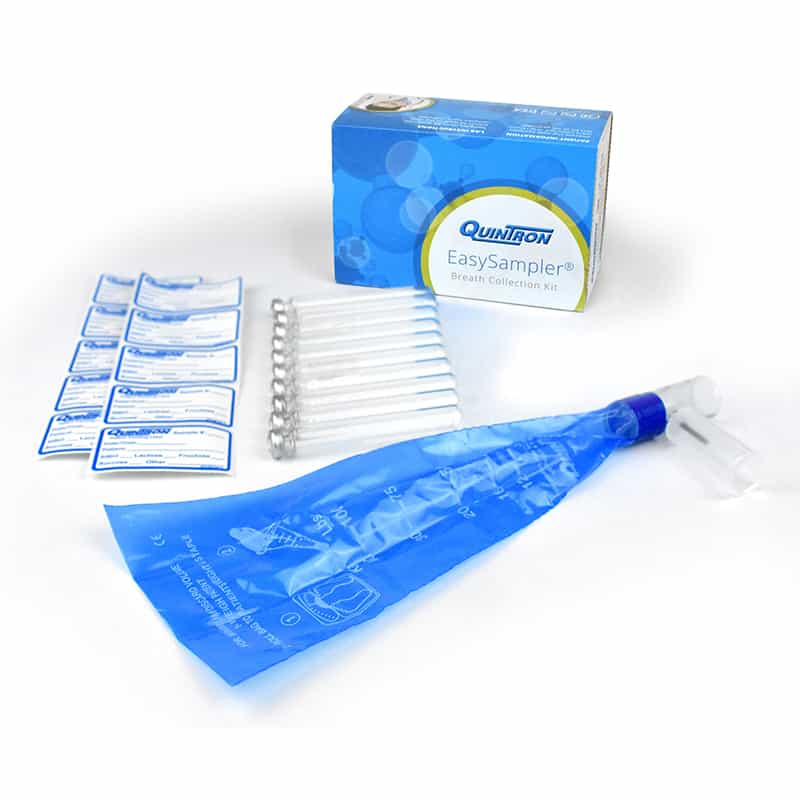SIBO staat voor Small Intestine Bacterial Overgrowth en treedt op wanneer normale bacteriën in overmatige aantallen in de dunne darm leven, wat een ravage veroorzaakt. Geschat wordt dat gemiddeld 60% van alle prikkelbaredarmsyndroom daadwerkelijk wordt veroorzaakt door SIBO, waarbij tot 84% van de IBS-patiënten SIBO heeft in één studie. U kunt meer lezen over SIBO in onze Wat u moet weten over SIBO artikel. In dit artikel bekijken we wat een SIBO-test is, hoe u getest kunt worden en wanneer u zou moeten overwegen om opnieuw te testen.
Zodra u een opgeblazen gevoel, diarree, constipatie, buikpijn of SIBO-symptomen ervaart, is het belangrijk om een SIBO-test te doen. SIBO kan een chronische en vaak gecompliceerde aandoening zijn om te behandelen. Dus voordat u met een behandeling begint, is het belangrijk om u eerst te laten testen. Dit komt omdat we willen weten of SIBO uw symptomen veroorzaakt, en zo ja, welk type SIBO u heeft.
Het goede nieuws is dat er verschillende manieren zijn om getest te worden op SIBO:de SIBO ademtest en jejunale aspiratie.
Als u PDS . heeft , chronische buikklachten, coeliakie, de ziekte van Crohn of colitis ulcerosa, kunt u overwegen zich te laten testen op SIBO. Er zijn verschillende behandelingsopties beschikbaar voor SIBO en het identificeren van de aanwezigheid ervan opent de opties voor verlichting van de bijbehorende symptomen. Het goede nieuws is dat er een aantal verschillende manieren zijn om te testen, die we hieronder onderzoeken.
SIBO kan momenteel worden getest met behulp van verschillende methoden, waaronder ademtest en jejunale aspiratie.

Een SIBO-ademtest is niet-invasief, gemakkelijk uit te voeren, kan thuis of in de kliniek worden gedaan en is de meest gebruikelijke methode om op SIBO te testen. Het werkt door waterstof en/of methaan in de adem te meten met specifieke tussenpozen, gedurende een bepaalde periode, nadat een persoon een suikeroplossing (lactulose of glucose) heeft gedronken. U kunt deze gratis online quiz doen om de kans te bepalen dat SIBO aanwezig is voordat een test wordt besteld.
Een persoon wordt als positief voor waterstof SIBO beschouwd als hij binnen de eerste 100 minuten een stijging van 20ppm (parts per million) heeft ten opzichte van de laagste voorgaande waarde.
Een persoon wordt als positief voor methaan SIBO beschouwd als hij binnen de eerste 100 minuten een stijging van 12 ppm heeft ten opzichte van de laagste voorgaande waarde.
Als de stijging optreedt gedurende 100-120 minuten voor waterstof of methaan, wordt dit als een grenswaarde beschouwd.
Sommige patiënten ervaren hoge baselineniveaus. Sommige artsen interpreteren dit als een positief testresultaat. Bij methaan SIBO is dit met name het geval omdat een hoge baseline en een vroege opkomst een standaard methaanpatroon is. Onjuiste voorbereiding kan worden aangegeven wanneer gasniveaus dalen na een verhoogde basislijn en blijven dalen of laag blijven gedurende de eerste twee uur.
Het volgende moet worden nageleefd om ervoor te zorgen dat de resultaten van de SIBO-ademtest betrouwbaar zijn.
Een maand eerder: Geen colonoscopieën, bariumonderzoeken, colonics of antibioticagebruik.
Een week eerder: Stop alle probiotica, producten die probiotica bevatten (bijv. yoghurt, gefermenteerd voedsel), antimicrobiële kruiden.
Een dag eerder: Stop laxeermiddelen, spijsverteringshulpmiddelen (bijv. Enzymen, zoutzuur), niet-essentiële supplementen. Volg een prep-dieet en 12 uur vasten.
Een eenvoudig dieet met weinig fermenteerbare koolhydraten en vezels moet 24 uur voor aanvang van de test worden gevolgd. Als een persoon constipatie heeft, moet hij het dieet 48 uur volgen.
Elk laboratorium heeft iets andere toegestane voedingsmiddelen, maar ze bevatten over het algemeen eieren, witte vis, kip, kalkoen, witte rijst, harde oude kaas, eieren, heldere vleesbouillon (gemaakt zonder botten en groenten), olijfolie en kokosolie om te koken, zout en peper voor kruiden, zwakke zwarte thee en koffie en gewoon water. Als u voorafgaand aan het testen geen voedingsinstructies hebt gekregen, wordt u aangeraden contact op te nemen met de instelling om te bevestigen wat ze nodig hebben, zodat u de resultaten niet per ongeluk vertekent.
Naast het dieet is een vastentijd van 12 uur vereist onmiddellijk voorafgaand aan het testen om het voedsel door de dunne darm te laten gaan en deze relatief leeg achter te laten.

De 24 uur voorafgaand aan het testen kunnen er als volgt uitzien:
Dag 1:
7 uur: Roerei met een kopje slappe zwarte thee of koffie.
10 uur: Kop warme vleesbouillon.
13:00: Gegrilde visfilet met jasmijn- of basmatirijst.
16.00 uur: Kop soep gemaakt van vleesbouillon en jasmijn- of basmatirijst.
19.00 uur: Gegrilde kip met jasmijn- of basmatirijst.
7.30 uur - 7.30 uur: Geen voedsel. Alleen water.
Dag 2:
6.30 uur tot einde test: Niet roken (of passief roken), niet sporten, niet slapen. U kunt uw tanden gewoon poetsen.
7.30 - 10.30 uur: SIBO ademtest. Tijdens het testvenster kunnen kleine hoeveelheden gewoon water worden gedronken.
10.30 uur en verder: Eet normaal verder.
"Het doen van een SIBO-ademtest gaf me gemoedsrust. Door een SIBO-diagnose te krijgen, wist ik eindelijk wat er met mijn darmen aan de hand was. Mijn behandelaar had een plan en we beginnen behandeling onmiddellijk. Eindelijk was ik op weg naar herstel van mijn slopende darmsymptomen.
Rebecca Coomes
De SIBO-ademtest heeft mensen over de hele wereld de kans gegeven om antwoorden te krijgen over wat er in hun buik omgaat.

Makkelijk te doen






















Betaalbaar






















Relatief snel te doen (3 uur)






















Snel resultaten behalen






















Meest voorkomende SIBO diagnostische test






















Kan zowel waterstof als methaan SIBO diagnosticeren






















Niet geschikt voor mensen die niet in een buis kunnen blazen






















Kan waterstofsulfide SIBO niet diagnosticeren






















Suikeroplossing kan de symptomen tijdelijk verergeren






















Lactulose is a prescription item in the US






















Glucose only measures SIBO in first 3 feet of small intestine






















Requires proper preparation, fasting for 12 hours and 3 hours to do the test






















May provide false negative and false positive results in some patients due to improper preparation or other conditions affecting gut transit time
Want to learn more about SIBO breath testing? Listen to my podcast interview with Eric Hamilton from QuinTron Instrument Company, the leading manufacturers of the SIBO breath testing equipment.
An aspirate can be taken from the second part of the small intestine. This can be performed by an endoscopy in-clinic, generally under anaesthesia or sedation. A sample is taken and the culture is grown to determine what bacteria are present.
This test is invasive, costly and difficult to find because it requires a highly skilled medical professional to undertake the test. For these reasons, it is not commonly used.
It can also produce false-negative results if the bacterial overgrowth is further down the small intestine, where the sample hasn't come from, if the sample size was too small, or if the bacteria that was collected can't be cultured.
Your doctor's office will have specific instructions for preparing for a jejunal aspirate, but they may be similar to the SIBO breath test prep.






















Considered gold standard by some practitioners






















Invasive






















Expensive






















Requires sedation or anaesthetic






















Time consuming






















Requires a gastroenterologist to perform procedure






















Greater risks as a medical procedure






















Can produce false negative and positives results
Stool testing can be very informative about a person's large intestine health and their broader GI health. It can show if there are imbalances or pathogenic organisms. However, it cannot diagnose SIBO as by its very nature, the stool test cannot determine where the bacterial overgrowth is occurring. The overgrowth could be from the large intestine, the small intestine or both.
If it is not possible for a person to undertake a breath test, such as for very young children who cannot blow into a tube, this can be a good indicative starting point until a breath test can be taken.
Bacteria and fungus produce organic acids which are excreted in your urine. A urine organic acids test measures the level of organic acids that you have excreted, giving you an indication that you may have a yeast or bacterial overgrowth somewhere in your body.
However, like the stool test, it is unable to pinpoint exactly where the overgrowth is occurring, and for this reason, cannot be used to definitively diagnose SIBO.
Researchers and breath test manufacturers are working on a commercially suitable test for Hydrogen Sulfide SIBO, which should be available in the coming years. There may also be exciting developments with the use of smart devices, which are swallowed and can take samples along the entire length of the small intestine tract.
A positive SIBO test means you either have hydrogen, methane, or suspected hydrogen sulfide SIBO. The next step is to find a practitioner who is experienced in treating SIBO. A SIBO specialist will recommend a course of treatment based on what SIBO you have, what type of treatment you feel most comfortable with and what they clinically see delivers the best results. There are 3 current SIBO treatment protocols:antibiotics, herbal antimicrobials and the Elemental Diet.
Some patients only need to do one of the three treatment options to recover from SIBO. However, for two-thirds of people, SIBO is a chronic, recurring condition and multiple rounds are required of one or all three of the available treatments.
Remember, no two people are the same. We’re all on different journeys so you need to make sure that you’re with the right practitioner who helps you to understand your condition, and who has the expertise and a depth of knowledge required to treat SIBO.
If, after a round of treatment, you don't feel a noticeable improvement, then it may be worth considering re-testing for SIBO. This can provide your practitioner with useful information, such as whether the treatment was effective, which gas(es) is still present and what treatments should be utilised next.
However, it is important to remember that a person is more than their SIBO test results. How you feel is more important than what a test result says. If you feel better, that is a more important metric to hold onto. I have had many SIBO coaching clients who have tested positive for SIBO, yet feel remarkably better than when they first started treatment.
If you found this article on how to get tested for SIBO helpful, I would love to hear your thoughts. Simply leave a comment in the comments section below.
"I have chronic, relapsing SIBO. I listen to my body and let it guide me with symptoms. I re-test for SIBO on occasion when I want information on whether I have hydrogen, methane or both, what my gas levels are like, and what treatment I need to consider. I let my body tell me how I am actually feeling, not a test result.
Rebecca Coomes
Pin1383 Shares Lonsurf goedgekeurd voor gevorderde darmkanker
Laatste kankernieuws Je hoeft geen roker te zijn om longkanker te krijgen Vooruitgang op het gebied van algehele achteruitgang van longkanker Op het immuunsysteem gebaseerde medicatie bestrijdt endom
Lonsurf goedgekeurd voor gevorderde darmkanker
Laatste kankernieuws Je hoeft geen roker te zijn om longkanker te krijgen Vooruitgang op het gebied van algehele achteruitgang van longkanker Op het immuunsysteem gebaseerde medicatie bestrijdt endom
 Plezier en beleving:een reis door het spijsverteringsstelsel
Denk aan de contrasterende uitdrukkingen Ik eet om te leven en Ik leef om te eten. Wat uw kijk ook definieert, het kan worden gezegd dat voor de meeste mensen voedselinname een alledaags genot is en d
Plezier en beleving:een reis door het spijsverteringsstelsel
Denk aan de contrasterende uitdrukkingen Ik eet om te leven en Ik leef om te eten. Wat uw kijk ook definieert, het kan worden gezegd dat voor de meeste mensen voedselinname een alledaags genot is en d
 Als je een Gut-project was, hoe zou je er dan uitzien?
In de loop der jaren zijn we behoorlijk interessante bijnamen genoemd ... De SCD-jongens. The Digestive Dudes. The Leaky Gut Guys. En gewoon de oude Jordan en Steve... En hey, zolang we men
Als je een Gut-project was, hoe zou je er dan uitzien?
In de loop der jaren zijn we behoorlijk interessante bijnamen genoemd ... De SCD-jongens. The Digestive Dudes. The Leaky Gut Guys. En gewoon de oude Jordan en Steve... En hey, zolang we men